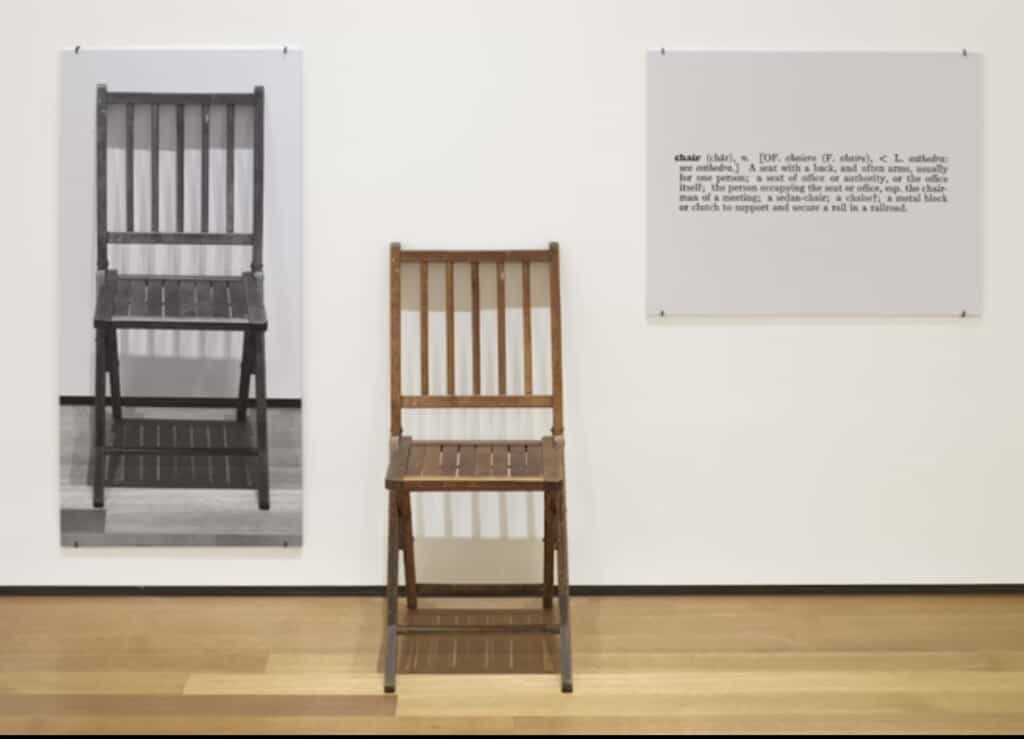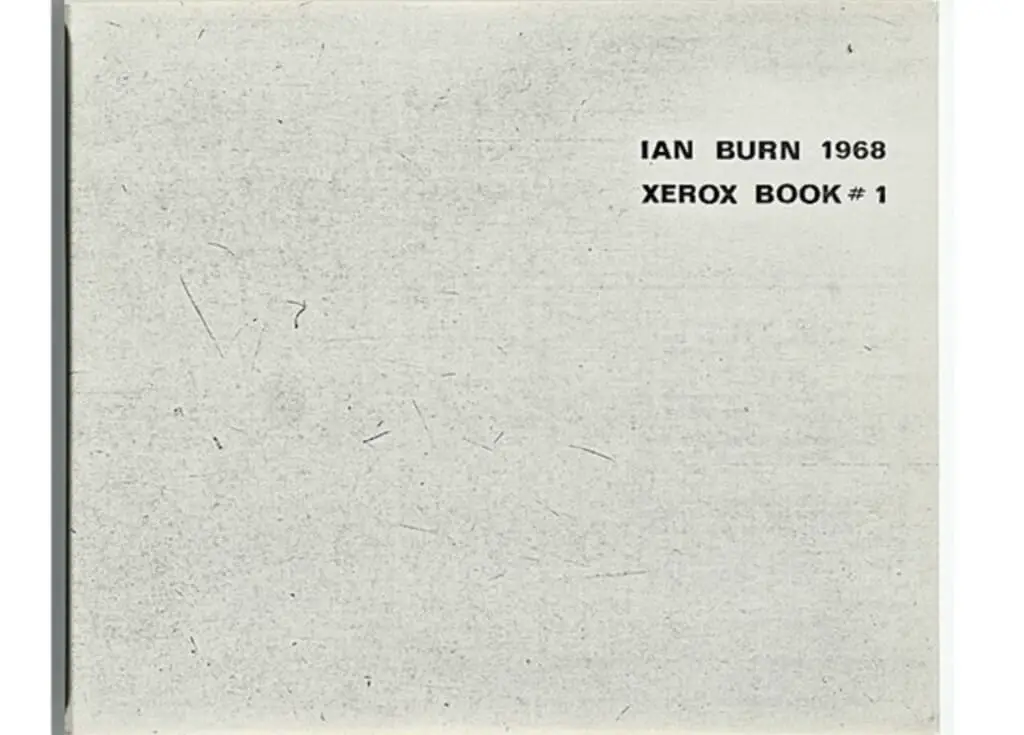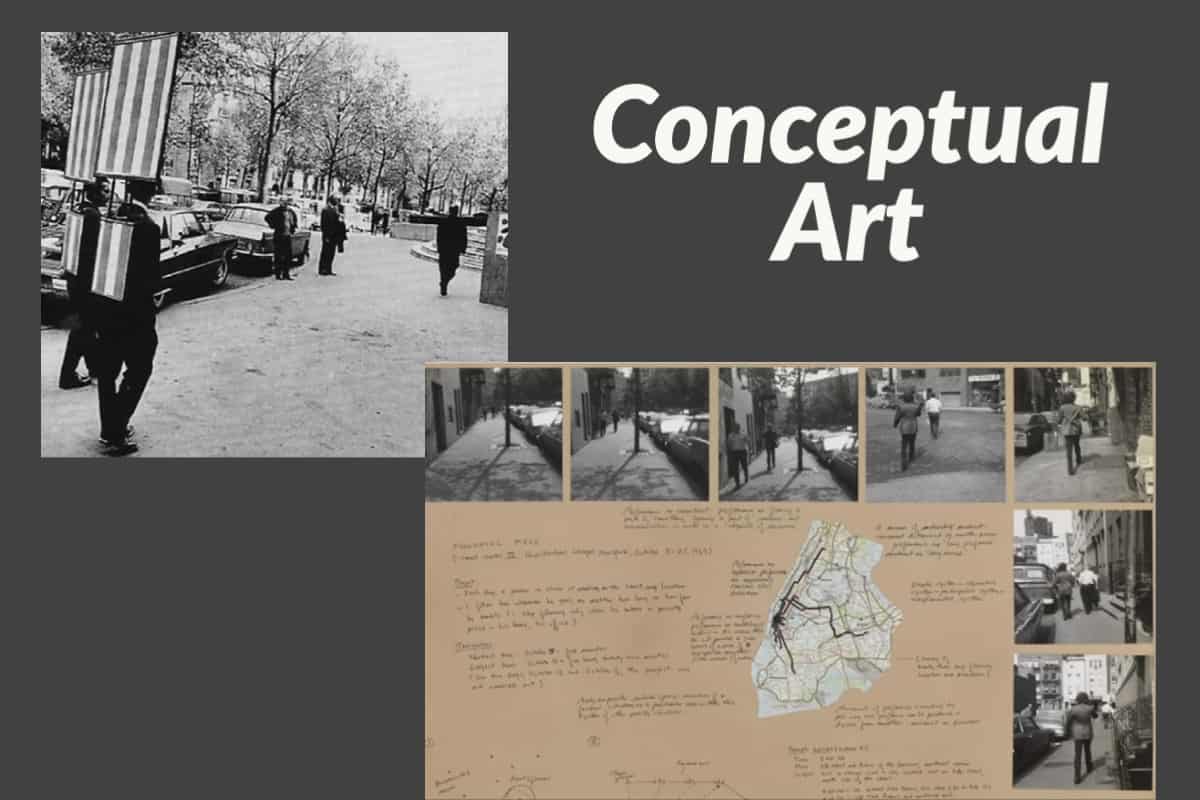The 1960s saw many different creative art movements emerge on the world art scene. One of these art movements that emerged from the mid-1960s to mid-1970s is the Conceptual Art Movement.
Conceptual art uses whatever materials, techniques, or form that the artist feels is most appropriate for the artist to get their artistic ideas across. Conceptual art can be almost anything from a display of objects to photographs to a performance. Almost anything goes with the Conceptual Art Movement.

Conceptual Art – The Anything And All Art
The Conceptual Art Movement can be confusing to many people. This is because Conceptual art can look like almost anything. This is why sometimes it can be difficult to define what conceptual art is and is not.
Conceptual art is also called conceptualism. Unlike other art movements, conceptual artists can use whatever materials, techniques, or form is the most appropriate for them to put their artistic ideas across. In reality, this can be anything from a performance to a written description.
It was the artist Sol LeWitt who is in 1967 first used the words Conceptual Art when he said:
“In conceptual art the idea or concept is the most important aspect of the work. When an artist uses a conceptual form of art, it means that all of the planning and decisions are made beforehand and the execution is a perfunctory affair. The idea becomes the machine that makes the art.”
Sol LeWit
As Sol LeWitt so eloquently said, Conceptual Art is about the concept of the art itself. Conceptual art is about the planning stages of the art as it is about the actual execution of the art.
Conceptual art also questions the nature of art itself. Can an everyday object really be considered a piece of art? Conceptual art is also about being in the moment of art in time and place. As the artist Douglas Huebler said:
“The world is full of objects, more or less interesting; I do not wish to add any more. I prefer, simply, to state the existence of things in terms of time and place.”
Douglas Huebler
Here is a really great video by PBS that explains and shows a lot of Conceptual Art. It is worth watching to be able to understand more about Conceptual Art.
Characteristics of Conceptual Art
Even though conceptual art started as a relatively loose form of art to describe different art types, certain trends started to emerge over time.
- Activism and Out in the World– Conceptual art was global or out in the world; this often blended with activism. The art was about rethinking the status quo of the time. An example of out in the world was 100 Boots Move On, by Eleanor Antin (1972). She took 100 boots around the United States and photographed them at different places. I Got Up by On Kawara (1968 to 1979); Kawara traveled around the world and then sent postcards to his friends that said “I GOT UP AT 8:43 A.M.” The postcards also had the address of where he was staying. He mailed these postcards to friends all over the world.
- Personal In Nature – Many times, conceptual art was was very personal in nature. An example of this is Carving: A Traditional Sculpture by Eleanor Antin (1972); Antin photographed herself naked each morning and then documented her weight loss of 10 pounds over 37 days.
- Worked Around Many of the Power Structures of Art World – Conceptual art was about working around many of the art world’s power structures at the time and art market concerns. For example, the General Strike Piece by Lee Lozano (1969), where she documented her process of withdrawing from the art world and her final visits to galleries and museums.
- Recording of Daily Life – Much of conceptual art was about the recording of daily life. There was no trickery or no need for anyone to interrupt what was being shown. Conceptual art was real art about real life. It was, in a sense, a recorded artistic history of life during this time. An example was Twenty-six Gasoline Stations by Edward Ruscha (1963), who photographed exactly Twenty-Six Gas Stations across the United States. Or Water Towers by Bernd and Hilla Becher (1972 – 2009) took photographs of water towers all across the United States.
Many conceptual artists believe that art is an art because they said it was art or placed it in an art setting. An object that before was mundane was now art. The conceptual artist’s Joseph Kosuth said this:
“The art consists of my actions of placing this activity (investigation) in an art context.”
Joseph Kosuth

Examples of Conceptual Art
As Conceptual art has so many forms and examples of art, some examples are best shown.
Here are some descriptions of some Conceptual artworks:
- Active Poetry, Ewa Partum (1971) – This conceptual art was a performance where poet Eva Partum took individual letters of the alphabet she had cut from paper and scatter them in city and countryside locations. The idea was that she was deconstructing language as she scattered the letters. (Tate Modern, London)
- One and Three Chairs, By Joseph Kosuth (1965)- – A display with an actual chair, a photo of a chair, and a chair’s definition. In this artwork, Joseph Kosuth is showing us things in a time and place.
- Xerox Book, by Ian Burns, (1968) – Ian Burns started with one piece of paper and then kept re-photocopying the paper. Each time he photocopied the paper, new lines would appear on the paper. This book he saw as a work in itself. He gave other fellow artists 25 pages to make a work that responded in some way to his Xerox book.
- Pose Work for Plinths by Bruce McLean (1971). This work by Bruce McLean is considered body art. Originally Bruce McLean conceived this as performance art but later turned it into body art. He poses in a variety of ways on what he considered to be pompous. (Tate Modern, London)
- A Wall Divided Vertically into Fifteen Equal Parts: Each With a Different line Direction and Color, and all Combinations, Sol LeWitt (1970) – Sol LeWitt wrote out instructions on creating some wall -drawings. The instructions consisted of text, diagrams, and outlined how his wall drawings could be produced. Since then, many have used his instructions to make his work of art. This work by Sol LeWitt was considered an installation as anyone could follow the instructions to make the art. (Tate Modern, London)
- I Like America and America Likes Me, by Joseph Beuys (1974) – Joseph Beuys wrapped himself in felt and spent three days in a room with a coyote. His work was Anti- Vietnam War protest and reflected his deep-seated beliefs about the damage to the native Americans through America’s settlement by the Europeans. (Tate Modern, London)
- A-Line Made By Walking, by Richard Long (1967). This conceptual art is considered land art. Richard Long walked backward and forward in a straight line on a field until he flattens the turf and the sunlight caused the line to appear. He then photographed the work. (Tate Modern, London)
When people look at conceptual art, they wonder if conceptual art is really art at all, or is it just objects or photos that have been taken and placed to look like art? I have found that the more I understand conceptual art, the more interesting it becomes, and the more I can start to understand what the artist meant by their artwork.
Related Questions
Who Was The Artist Carl Heinrich Bloch?
One of Denmark’s greatest artists, Carl Bloch, almost did not become an artist. His parents wanted him to join the Navy, but he was consumed with art and proved early in life to be artistically gifted. Throughout his life, he painted many important paintings. One of his most important art commissions was to paint 23 scenes from the life of Christ at the Fredriksborg Castle in Denmark. Later in life, he became a very skilled printmaker. Carl Bloch was married and had eight children. Both Carl and his wife Alma died quite young.
You can learn more by reading 18 Facts About The Artist Carl Heinrich Bloch (1834 – 1890) by clicking here.
Who Was Henriette Ronner-Knip The Painter of Cats & Dogs?
Henriette Ronner-Knip came from a family of artists. At an early age, she became in charge of the family’s finances and other legal obligations, so she started to paint. She sold her first painting at the age of 15-year-old. Later, when she was married, Her husband became her manager, and Henriette continued to paint. She is famous for her many wonderful paintings of cats and dogs. She chooses to paint dogs and cats as a subject matter because during the Victorian era, having a pet in your household was popular.
You can discover more by reading Henriette Ronner-Knip (1821-1909), Painter of Cats & Dogs by clicking here.

